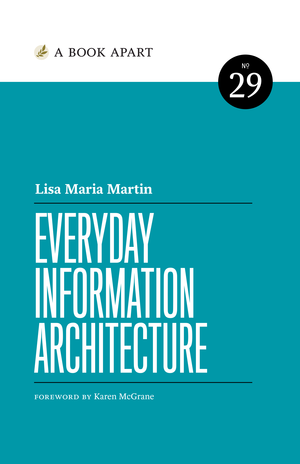Book Review - Everyday Information Architecture

;TLDR A good primer if you are planning your first site re-organization, includes a lot of core fundamentals for those new to IA and general UX practices.
Everyday Information Architecture by Lisa Maria Martin is a 2019 release from A Book Apart, the publishing arm of A List Apart. I purchased this on a whim as I have always wanted to add more structure to how I tackle site re-organizations.
At 116 pages it is a quick read, with many screenshots of web pages and 1/2 page pie charts. While reading this book did add some interesting tidbits for me, and may have helped me avoid some pitfalls in my first 2 site re-structures, it is really for someone who has never tackled a large project like this before.
Martin’s writing style is fun, factual and easy to comprehend, she has a great way of laying out the problem at hand, then tackling it. There are a few places where I would have liked to have her drill down more, but that may have changed the scope of the book to being a more in-depth look rather than a quick start guide.
The first place I would have liked a little more info is about leveraging existing site traffic, dwell time, time on page and other page data from site analytics to guide how categories and pages on the site are structured. On-site search data is a gold mine of user data that frequently shows where the previous taxonomy is failing.
The second place is how she approached SEO. I understand her feelings expressed in chapter 5, and they are not without founding, however it would have been nice to have some encouragement about what to do instead of what not to do. Being equipped to deal with change requests justified by SEO is a critical part of navigating a frequently politically charged project, while covering SEO in depth is well outside of the scope of this book, a reference or guidance on what to look for would have been a nice touch.
Finally I was surprised that there were no referenced to some common exercises like card sort and user navigation testing, while Treejack and Optimal Workshop are listed in the Tools section at the back of the book, I couldn’t locate a reference to user testing or incorporating feedback from testing in the body of the book.
In summary: get this before diving into a site restructure for the first time, or pass it a long to junior members of the project, then fill in some of the gaps I mentioned above.